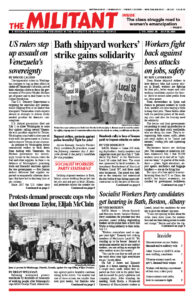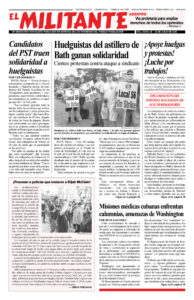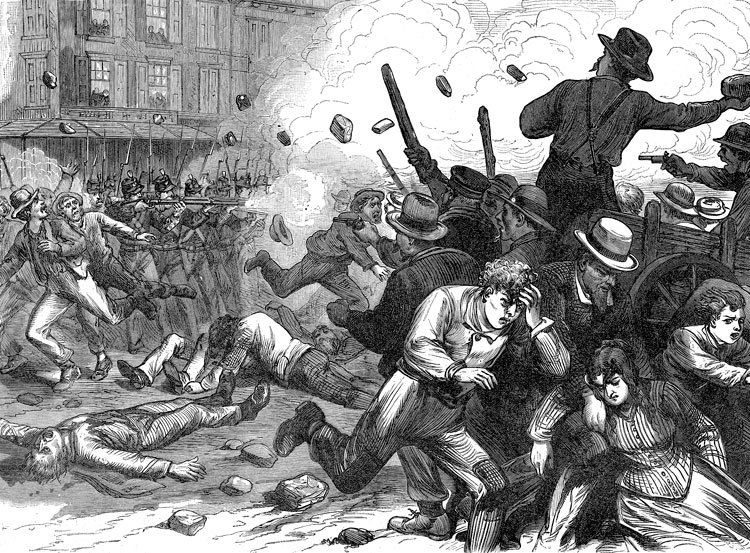Revolutionary Continuity: The Early Years 1848-1917 by Farrell Dobbs is one of Pathfinder’s Books of the Month for July. This is the first of two volumes that document the birth and growth of the communist movement in the U.S. Dobbs emerged as a young leader of the 1934 Minneapolis Teamster strikes and joined the Communist League of America. He was the chief architect and leader of the Teamsters’ 11-state campaign that organized over a quarter of a million over-the-road drivers into a powerful union that transformed the Upper Midwest into union territory, the legacy of which is felt to this day. Dobbs was national secretary of the Socialist Workers Party from 1953 to 1972 and the SWP’s presidential candidate four times. This excerpt is from Chapter 3: “Gains and Setbacks.” Copyright © 1980 by Pathfinder Press. Reprinted by permission.
During the 1884-86 labor upsurge large numbers of both native-born and foreign-born workers joined trade unions. This widening discontent with existing social conditions led to an expansion of the workers’ united struggles as a class, which manifested itself in a series of strikes over economic demands. Then, early in 1886, the conflict assumed political characteristics with a massive strike wave in support of the eight-hour day. While trade unions directed this demand against one or another particular employer in economic struggles, it had broader significance. The workers as a class were pressing a political issue against the capitalists as a class, explicitly so in calling for laws to limit the hours of labor.
The indicated next step for trade unionists was building their own political organization, and they moved instinctively in that direction. By the fall of 1886 labor parties, with platforms that varied from city to city, had again sprung up in several industrial centers and were running candidates for public office. …
A major campaign was organized in New York City, where the Knights of Labor, the Federation of Organized Trades and Labor Unions, and the Socialist Labor Party acted jointly to launch a mass party in labor’s name. A majority chose Henry George to head the new party’s slate as its nominee for mayor. He was the leader of a petty-bourgeois sect that advanced a taxation scheme as a cure-all for the evils inflicted by capitalism. It centered on the notion that all social ills were rooted in the private ownership of land. …
But this strategy left the existing social relations of production untouched. Without the expropriation of the decisive forms of productive property, the industrial and financial bourgeoisie would remain free to exploit the toiling masses, who produce the surplus value that is the source of all rents, interest, and profit. And they would continue to use their ownership of capital to maintain political sway over the nation. Hence, the whole proposal was reformist to the core.
Nevertheless, the “single tax” panacea of Henry George, the main candidate, was included in the New York party’s platform. The socialists — who rejected the “single tax” fallacies — backed the campaign organized around the George ticket, because what was decisive was organized labor’s stepping forward into the political arena as an independent class force.
Labor party campaigns launched in other cities were supported by the Socialist Labor Party for the same reason. The various platforms for these independent mass political actions focused on issues of immediate concern to the workers in each locality. Little or no attention was given to the “single tax” idea, which remained limited essentially to New York.
The labor slates, taken as a whole, made an impressive showing in the November 1886 elections. Henry George, for example, got almost a third of the total vote cast in New York. Elsewhere, candidates put forward by the organized workers were in a few instances elected, and the overall results of the balloting maintained interest in the developing independent political action. The workers’ mood opened the door to uniting the several local labor parties as the first step in building a national political movement. Engels took up this perspective in the letter of November 29, 1886, to Sorge, cited previously, centering his remarks on the New York situation.
“The first great step of importance for every country newly entering into the movement is always the constitution of the workers as an independent political party,” he counseled, “no matter how, so long as it is a distinct workers’ party. And this step has been taken, much more rapidly than we had a right to expect, and that is the main thing. That the first program of this party is still confused and extremely deficient, that it has raised the banner of Henry George, these are unavoidable evils but also merely transitory ones. The masses must have time and opportunity to develop, and they can have the opportunity only when they have a movement of their own — no matter in what form so long as it is their own movement — in which they are driven further by their own mistakes and learn through their mistakes. . . . If there are people at hand there whose minds are theoretically clear, who can tell them [the workers] the consequences of their own mistakes beforehand and make clear to them that every movement which does not keep the destruction of the wage system constantly in view as the final goal is bound to go astray and fail — then much nonsense can be avoided and the process considerably shortened.” …
To follow this advice the socialist movement needed to act flexibly in collaborating with the existing labor parties, city by city, to help them shape a common program. If the party’s initial program dealt with important aspects of labor’s interests as a distinct social class; if it set forth aims upon which all concerned were agreed — it could help advance toward a mass nationwide working-class party. At the start the Marxists within the labor party would have to tentatively and partially indicate the course required for the workers’ emancipation from capitalist exploitation. Time and experience could then make it possible for the party to develop explicit anticapitalist political goals and strategy.


